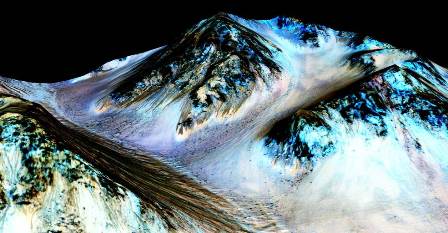NASA Confirms Liquid Water on Mars

September 29, 2015
On Monday, September 28, NASA held a press conference promising that they had major news regarding Mars. Boy, did they deliver.
At about 11:30 a.m., NASA revealed to the world that they found traces of water on Mars. The water is said to still flow crosswise on the ancient red surface of what is Mars; however, it flows infrequently.
“Our quest on Mars has been to ‘follow the water,’ in our search for life in the universe, and now we have convincing science that validates what we’ve long suspected,” said John Grunsfeld, astronaut and associate administrator of NASA’s Science Mission Directorate in Washington. “This is a significant development, as it appears to confirm that water — albeit briny — is flowing today on the surface of Mars.”
The downhill streaks that gave scientists reason to believe flowing water existed on the Red Planet are called recurring slope lineae (RSL).
“We found the hydrated salts only when the seasonal features were widest, which suggests that either the dark streaks themselves or a process that forms them is the source of the hydration. In either case, the detection of hydrated salts on these slopes means that water plays a vital role in the formation of these streaks,” said Lujendra Ojha of the Georgia Institute of Technology (Georgia Tech) in Atlanta.
Ojha said he first noticed these ambiguous features as a University of Arizona undergraduate back in 2010.
“It remains unclear where the water comes from. Theories include deliquescence, melting subsurface ice or even a liquid-water aquifer that feeds the process. Discovering what precisely is causing the phenomenon is a mystery for the next round of investigations,” explained Michael Meyer, lead scientist for NASA’s Mars Exploration Program at the agency’s headquarters in Washington .
The important thing about the discovery of water on Mars is what it brings to the future of humanity. With water comes the possibility of life. “It took multiple spacecraft over several years to solve this mystery, and now we know there is liquid water on the surface of this cold, desert planet,” said Meyer. “It seems that the more we study Mars, the more we learn how life could be supported and where there are resources to support life in the future.”













